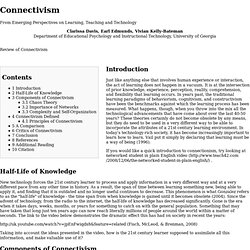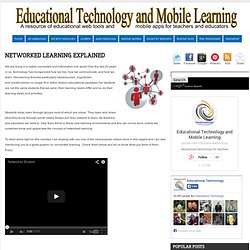

Connectivisme. Qu'est-ce que le connectivisme ? Les théories et les modèles de l'apprentissage se suivent et ne se ressemblent pas forcément; chacun présente une approche spécifique avec ses avantages et ses limites et on n'a pas toujours intérêt à adopter inconditionnellement l'une ou l'autre de ces approches.

Le modèle transmissif où l'enseignant est le détenteur du savoir et s'évertue à le transmettre à un apprenant qui aspire à correspondre à un modèle a vu ses beaux jours décliner quoiqu'il soit encore appliqué dans des bastions réfractaires tels que certains espaces universitaires traditionnels (et les xMoocs). Le béhaviorisme, avec le balisage de l'apprentissage du plus simple au plus complexe avec force renforcements, positifs et/ou négatifs, des informations fournies juste à temps à l'apprenant et les remédiations pertinentes qui récupèrent tout retardataire vivra encore de très beaux jours et amènera des réussites ponctuelles satisfaisantes.
Toutes ces approches correspondent à des pratiques courantes dans l'apprentissage. Connectivism. From Emerging Perspectives on Learning, Teaching and Technology Clarissa Davis, Earl Edmunds, Vivian Kelly-Bateman Department of Educational Psychology and Instructional Technology, University of Georgia Review of Connectivism Introduction Just like anything else that involves human experience or interaction, the act of learning does not happen in a vacuum.

It is at the intersection of prior knowledge, experience, perception, reality, comprehension, and flexibility that learning occurs. If you would like a quick introduction to connectionism, try looking at networked student in plain English video. Half-Life of Knowledge New technology forces the 21st century learner to process and apply information in a very different way and at a very different pace from any other time in history. (Fisch, McLeod, & Brenman, 2008) Taking into account the ideas presented in the video, how is the 21st century learner supposed to assimilate all this information, and make valuable use of it? Dessus:connectivisme [forse] Définition Le connectivisme est un concept développé par Georges Siemens1) et Stephen Downes2) qui proposent de revisiter la question de l’apprentissage à l'ère numérique, i.e. dans un monde en réseaux.
![dessus:connectivisme [forse]](http://cdn.pearltrees.com/s/pic/th/dessus-connectivisme-forse-67611938)
Le texte fondateur, « A Learning Theory for the Digital Age » (Siemens, 2004), expose ce modèle théorique comme une alternative aux paradigmes traditionnels (behaviorisme, cognitivisme, constructivisme). Il considère que l’apprentissage est un processus de connexions au sens large, englobant les connexions neuronales, les connexions entre les hommes, les ordinateurs, mais aussi l’interconnexion entre les différents champs de savoirs. L’idée centrale est la notion de réseaux dans une vision systémique de l’apprentissage. Pour Siemens, le savoir est davantage un flux qu’un produit («Knowledge as a river, not reservoir») (Siemens, 2006, p.53). Brève mise en perspective historique Source : Siemens, 2006, p. 81 Les principes du connectivisme 1. 2. 3. 4. 5. 6. 7.
Www.downes.ca/files/Connective_Knowledge-19May2012.pdf. Connectivism. Networked Learning Explained. We are living in a highly connected and information-rich world.Over the last 20 years or so, technology has reorganized how we live, how we communicate, and how we learn.

Old learning theories particularly behaviourism, cognitivism, and constructivism no longer fit in within today's educational paradigm.Our students are not the same students that we were, their learning needs differ and so do their learning styles and priorities. Students today learn through groups most of which are virtual. They learn and share what they know through social media.Simply put: they network to learn. As teachers and educators we need to help them thrive in these new learning environments and this can not be done unless we ourselves know and appreciate the concept of networked learning. To shed some light on this concept, I am sharing with you one of the most popular videos done in this regard and I am also introducing you to a great graphic on connected learning . Courtesy of Connected Learning.
MOOC Révolution ou simple effet de mode ? Home. Connectivism: A Learning Theory for the Digital Age. Connectivism: A Learning Theory for the Digital Age December 12, 2004 George Siemens Update (April 5, 2005): I've added a website to explore this concept at www.connectivism.ca Introduction Behaviorism, cognitivism, and constructivism are the three broad learning theories most often utilized in the creation of instructional environments.

Learners as little as forty years ago would complete the required schooling and enter a career that would often last a lifetime. “One of the most persuasive factors is the shrinking half-life of knowledge. Some significant trends in learning: Many learners will move into a variety of different, possibly unrelated fields over the course of their lifetime. Background Driscoll (2000) defines learning as “a persisting change in human performance or performance potential…[which] must come about as a result of the learner’s experience and interaction with the world” (p.11). Driscoll (2000, p14-17) explores some of the complexities of defining learning.
Conclusion: Connectivism. Connectivisme.